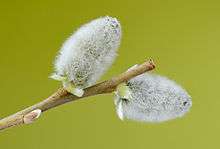Pussy willow
Pussy willow is a name given to many of the smaller species of the genus Salix (willows and sallows) when their furry catkins are young in early spring. These species include (among many others):
- Goat willow or goat sallow (Salix caprea), a small tree native to northern Europe and northwest Asia.
- Grey willow or grey sallow (Salix cinerea), a small tree native to northern Europe.
- American pussy willow (Salix discolor), native to northern North America.

Before the male catkins of these species come into full flower they are covered in fine, greyish fur, leading to a fancied likeness to tiny cats, also known as “pussies”. The catkins appear long before the leaves, and are one of the earliest signs of spring. At other times of year trees of most of these species are usually known by their ordinary names.
Cultural traditions
Asia
The many buds of the pussy willow make it a favourite flower for Chinese New Year (Lunar New Year). The fluffy white blossoms of the pussy willow resemble silk, and they soon give forth young shoots the colour of green jade. In Chinese tradition, this represents the coming of prosperity.[1] Towards the Lunar New Year period in spring, stalks of the plant may be bought from wet market vendors or supermarkets.
Once unbundled within one's residence, the stalks are frequently decorated with gold and red ornaments—ornaments with colours and textures that signify prosperity and happiness. Felt pieces of red, pink, and yellow are also a common decoration in Southeast Asia.
Xie Daoyun's comparison of snow and willow catkins is a famous line of poetry and is used to refer to precocious young female poets.[2]
Europe
The flowering shoots of pussy willow are used both in Europe and America for spring religious decoration on Palm Sunday, as a replacement for palm branches, which do not grow that far north.[3]
Ukrainian and Russian Orthodox; Ruthenian, Polish, Romanian, Czech, Slovak, Bavarian, and Austrian Roman Catholics; Finnish and Baltic Lutherans and Orthodox; and various other Eastern European peoples carry pussy willows on Palm Sunday instead of palm branches. This custom has continued to this day among Ukrainian Orthodox Church, Romanian Orthodox, Russian Orthodox, Ruthenian Catholic, Ukrainian Catholic, Kashubian Catholic and Polish Catholic émigrés to North America. Sometimes, on Palm Sunday they will bless both palms and pussy willows in church. The branches will often be preserved throughout the year in the family's icon corner.[4]
Pussy willow also plays a prominent role in Polish Dyngus Day (Easter Monday) observances, continued also among Polish-Americans,[5] especially in the Buffalo, New York, area.
Middle East
In Greater Iran it may be part of the decoration on the Haft-Seen table during the new year celebration of Nowruz on the first day of spring, and its distilled flower is used in traditional medicine.[6]
In popular culture
Pussy Willow, a children's book by Margaret Wise Brown (1951), tells the story of a grey "pussycat not much bigger than a pussywillow", who names himself Pussy Willow after the catkins he finds around him in Spring.[7] When the catkins disappear with the passing of the season, he goes in search of them, asking each different kind of animal he encounters where he might find them. The animals all answer from their own perspective. Up in the air, says the butterfly; under a leaf, says the squirrel. Pussy Willow finally finds them a year later when Spring comes around again. The original edition was illustrated by Leonard Weisgard.[8]
In the book The Best Christmas Pageant Ever by Barbara Robinson, the character Imogene Herdman argues with a girl named Alice over which of them will play the Virgin Mary in their school's upcoming Christmas pageant. Imogene threatens to stick a pussy willow down Alice's ear where no one would be able to reach it, and says: "And it'll sit there and grow and grow and grow. So for the rest of your life, there'll be a pussy willow bush growing out of your ear."[9]
"Pussy Willow" is a song by progressive rock group Jethro Tull on their album The Broadsword and the Beast.
References
- Paula Tracy (18 April 2014). "Pussy willows a sure sign of spring". Retrieved 24 April 2019.
- Fong, Grace S. (2008). Herself an Author: Gender, Agency, and Writing in Late Imperial China. University of Hawaii Press. p. 182. ISBN 978-0-8248-3186-8.
- Roy, Christian (2005). Traditional Festivals: A Multicultural Encyclopedia. 1. ABC CLIO. p. 350. ISBN 1-57607-089-1.
- Kharinov, Vyacheslav. "Some Have Palms, Some Have Pussy-Willows". Orthodox Christianity. Retrieved 24 April 2019.
- Williams, Victoria (2017). Celebrating Life Customs around the World: From Baby Showers to Funerals. ABC CLIO. p. 79. ISBN 978-1-4408-3658-9.
- Shirzad, Susanne (2018). My Persian Haft Seen: An Iranian Nowruz Tradition (1st ed.). Ibex Publishers. p. 38. ISBN 978-1-5881-4179-8.
- "Brown, Margaret Wise 1910–1952 - Dictionary definition of Brown, Margaret Wise 1910–1952". Encyclopedia.com. Retrieved 2019-04-24.
- "Books illustrated 1950–1955". Retrieved 2019-04-24.
- Barbara Robinson (1971). The Best Christmas Pageant Ever. HarperCollins. ISBN 9780060250447.